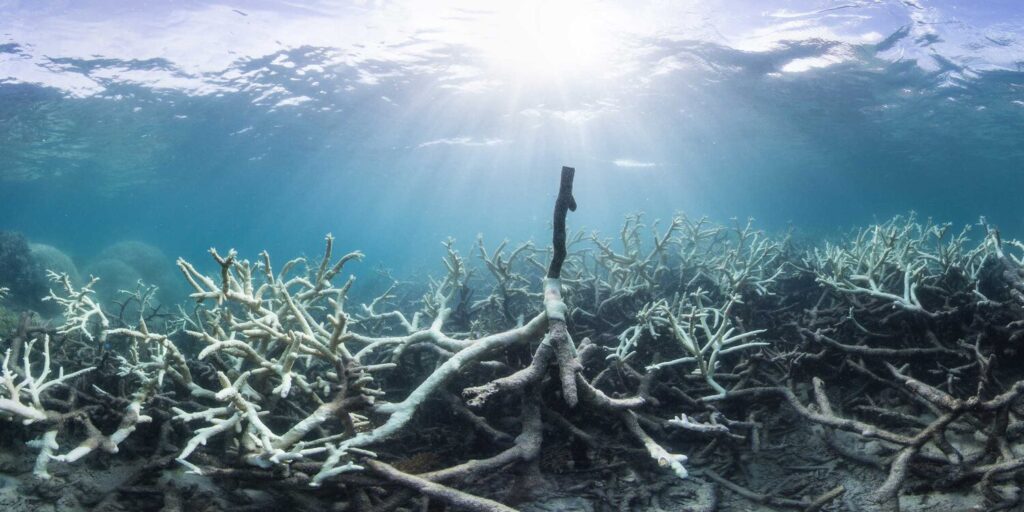With record-high temperatures combined with extreme climate and weather patterns; researchers say we must help communities plan how best to reduce the risks.

© Underwater Earth / XL Catlin Seaview Survey / Christophe Bailhache
Since April 2023, the global average temperature of water on the surface of the sea has been unusually high and rising. By August, the surface of northern hemisphere ocean reached record-high temperatures of 25 °C.
This rapidly warming trend, fuelled by the climate crisis, has manifested as a series of marine heatwaves — periods of unusually warm sea temperatures that can last weeks, months or even years — across the northern and southern hemispheres.
Marine heatwaves are becoming more frequent, stronger and longer-lasting. In some areas around the UK and Ireland, surface waters in June–July were 4–5°C above what is usually recorded at this time of the year. Temperatures are also soaring off the coast of Florida and into the Gulf of Mexico, extending across the tropical Pacific, around Japan, and off the coasts of Ecuador and Peru.
Marine heatwaves disrupt, threaten, and damage ecosystems. They are particularly dangerous for temperature-sensitive marine organisms that live in cool waters, such as kelps, invertebrates and fishes, and organisms that cannot move, such as corals. Many species may be susceptible to disease or mortality, with knock-on effects.
Such events also affect local communities, who suffer economic losses from fisheries and aquaculture impacts.
This makes the concurrent onset of a strong El Niño — a climate phenomenon that is typically associated with a rise in global temperatures — particularly worrying. El Niño is a major climate phenomenon that comprises a warm phase (El Niño), a cool phase (La Niña) and a neutral phase. El Niño has the most widespread impact on sea surface temperatures globally. These switch, irregularly, every few years. The combination of marine heatwaves and strong El Niño are particularly worrying.
Earlier in 2023 conditions in the tropical Pacific began to reverse and El Niño appears to be developing. This is likely to increase to the end of the year and possibly next year and is poised to trigger major marine heatwaves.
With impending El Niño conditions with long-term warming trends, it is vital to monitor and help develop plans to reduce risk to wildlife and economies.
In a recent article published in the journal Nature, researchers are urging decision makers in marine and coastal biodiversity conservation, fishing, aquaculture and tourism industries to set out a strategy to reduce risk before, during and after the event. They also set out four main priorities:
- Identify threatened regions
Historical data can show what areas suffered marine heatwaves during previous El Niños and suggest where future events are likely to occur.
- Improve forecasts and warnings
Developing new predictive models and improve the accuracy of current systems is crucial for local biodiversity efforts as well as fishing, aquaculture and tourism industries.
- Plan local responses
Seasonal early warning systems should be developed to inform conservation agencies, fishing and aquaculture industries, and the public. Some industries like aquaculture and fisheries may need to change or adapt practices before and during predicted heatwaves.
- Monitor impacts of warmer waters
To better understand ecological responses to extreme warming events, researchers should scale up monitoring efforts to understand more about the physical and biological conditions of a region before a heatwave occurs.
Scientists say that unfortunately, the climate crisis may eventually cause the ocean to reach a permanent heatwave state, and some regions may no longer support certain species and ecosystems.
Postdoctoral Research Assistant Dr Katie Smith from the Marine Biological Association (MBA) who co-authored the paper said: “Marine heatwaves are occurring with increasing regularity and it is crucial that we work towards predicting their impacts and implementing adaptive strategies to reduce the consequences of these events.
Regardless of whether marine heatwaves are exacerbated this year by an El Niño event, preparations to soften their impacts will help marine ecosystems and the industries that rely on them, offering them an opportunity to adjust or transform.”
Read the full article here: https://www.nature.com/articles/d41586-023-02730-2